| VP74/A16 UNITED STATES ATLANTIC FLEET | ||||||||||||||||||||||||||
PATROL SQUADRON SEVENTY-FOUR |
||||||||||||||||||||||||||
| (073-A) | ||||||||||||||||||||||||||
| Fleet Post Office, | ||||||||||||||||||||||||||
| New York, New York, | ||||||||||||||||||||||||||
| October 10, 1943. | ||||||||||||||||||||||||||
| C-O-N-F-I-D-E-N-T-I-A-L | ||||||||||||||||||||||||||
|
||||||||||||||||||||||||||
| 1. Enclosure (A) is forwarded herewith. | ||||||||||||||||||||||||||
| 2. Photographic negatives of this action are also forwarded in compliance with reference (a). | ||||||||||||||||||||||||||
| 3. Advance copies of this report are being forwarded direct to you; The Commander Air Force ATLANTIC Fleet, and the Aircraft Anti-Submarine Warfare Development Detachment, ATLANTIC Fleet. | ||||||||||||||||||||||||||
 |
||||||||||||||||||||||||||
| G. C. MERRICK | ||||||||||||||||||||||||||
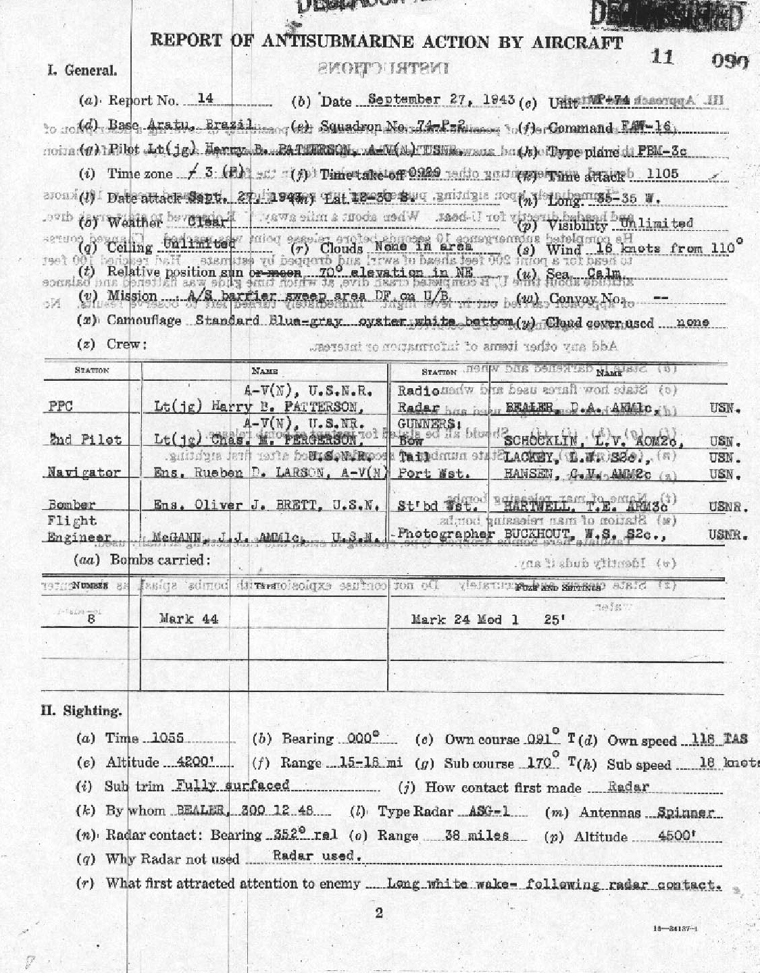
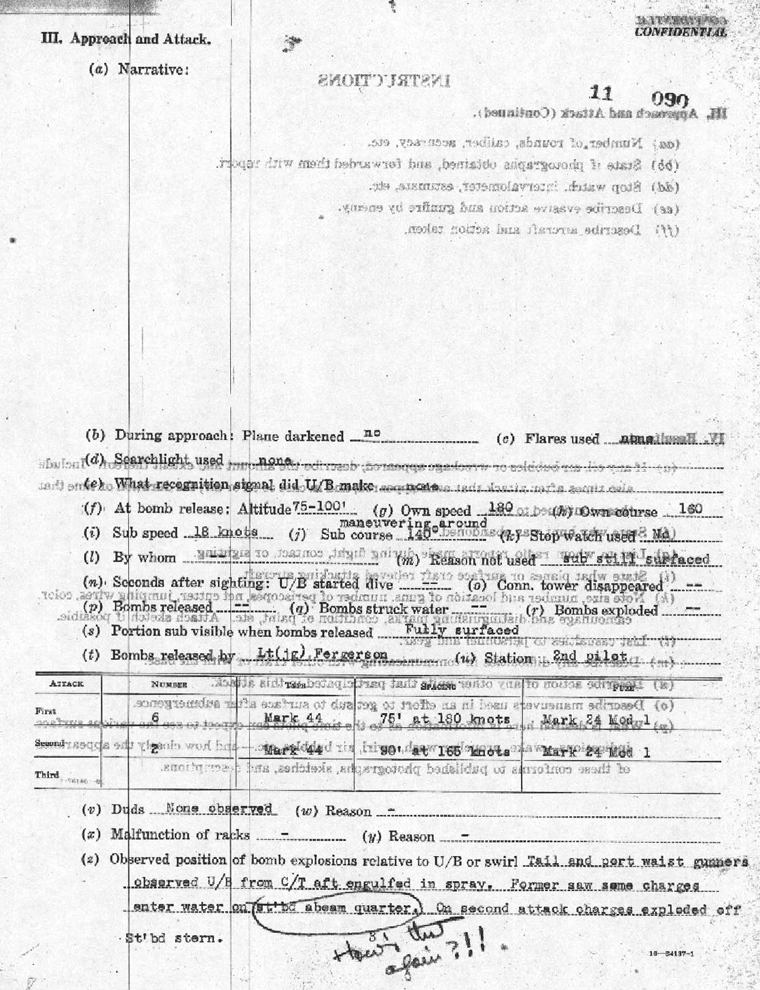
| III | ||
| (a) Narrative: | ||
| 74-P-2 was flying a barrier sweep in vicinity of DF obtained the previous evening. At 1050, the Radar operator, BEALER, reported a ship bearing 8° to Port, range 38 miles. Plane was on course of 091° T, speed 110 K, altitude 4500'. Closing range, the wake of a submarine was first sighted visually by the second pilot about 10 miles dead ahead, his course at right angles to ours headed to our right,. Battle Stations were manned, as we immediately increased speed and commenced a shallow turn to left to take advantage of the sun, as well as to get in position for a stern attack. No clouds were in area. I believe we were sighted at this time. About 7 to 8 miles distant, the sub opened fire while in a left turn, apparently attempting to bring his after guns to bear on us. (This was puzzling as in the past the subs usually turned to present a beam target.) The shells were exploding short, leaving white puffs in a line across our course. As we came within range, approximately 3 or 4 miles distant, some large brown puffs could be seen. The gunners were very accurate and the explosions made the air very turbulent. The bow gunner opened fire at about 3000 yds., the fire was falling short, getting on the target as the range closed. Lt(jg) FERGERSON, co-pilot, dropped a string of 6 MK 44 Torpex-filled D/C's as I passed over, or just forward of, the conning tower from sub's Port quarter at an angle of about 20 from stern, between 75 and 100' altitude, airspeed 185 knots. I made a sharp left turn. Sub appeared to be just emerging from bomb slick, most of which seemed to be on starboard side of sub's track. The sub started turning right. When the plane was broadside the sub again opened fire, the shells exploding off our port side. After reaching 800' altitude, I gave orders to standby and commenced 2nd attack. During this run, the fire was heavier and more accurate. We were hit just forward of galley door by a shell that exploded just as it struck. Ensign BRETT was emerging from bombing compartment after having reset the intervalometer. He was severely wounded by shrapnel and aluminum from this shell, as was Radioman BEALER. At this time I did not know that BEALER was hit nor where or how badly the plane was damaged. Lt(jg) FERGERSON dropped the remaining two bombs and the plane passed directly over the target from stern to bow at about 165 knots at 160' altitude. I immediately gained altitude believing there was a possibility that my engines or fuel tanks were damaged. Ensign LARSON, navigator, carried Ensign BRETT back aft to a bunk where KARSEN, administered first-aid. BEALER was sending M.O.'s. The Flight Engineer reported that we were hit in many places and that our inverter line was shot away putting our electric instruments out of commission. Just before reaching 2500' altitude at which I leveled off, I glanced back and noticed that BEALER was wounded in his right leg. He was still at his station helping Ensign LARSON with the amplifying report and had never reported being hit. After checking Ensign BRETT's injuries and the damage to plane I realized that he needed medical attention quickly. Although we were out of range at this time, the sub kept up a continuous fire. It maneuvered erratically after the 2nd attack and the speed was noticeably reduced. It squared away on straight course of 140° T and submerged at 1122 P. I flew over the swirl and dropped D/C Marker, and then departed for base. | ||
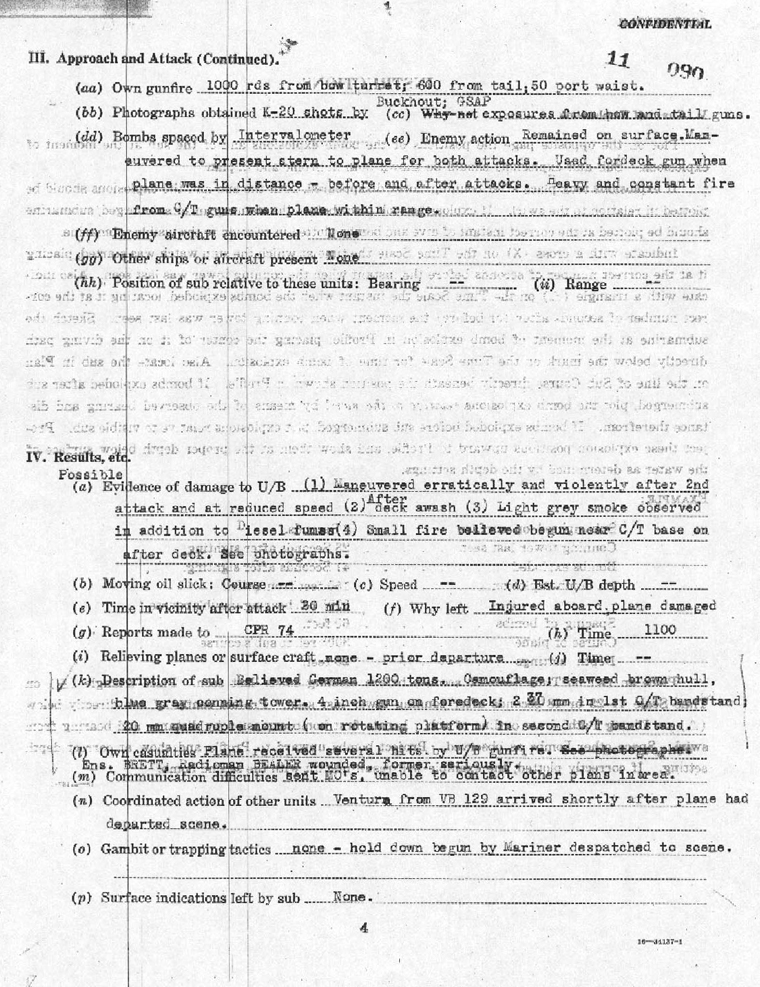
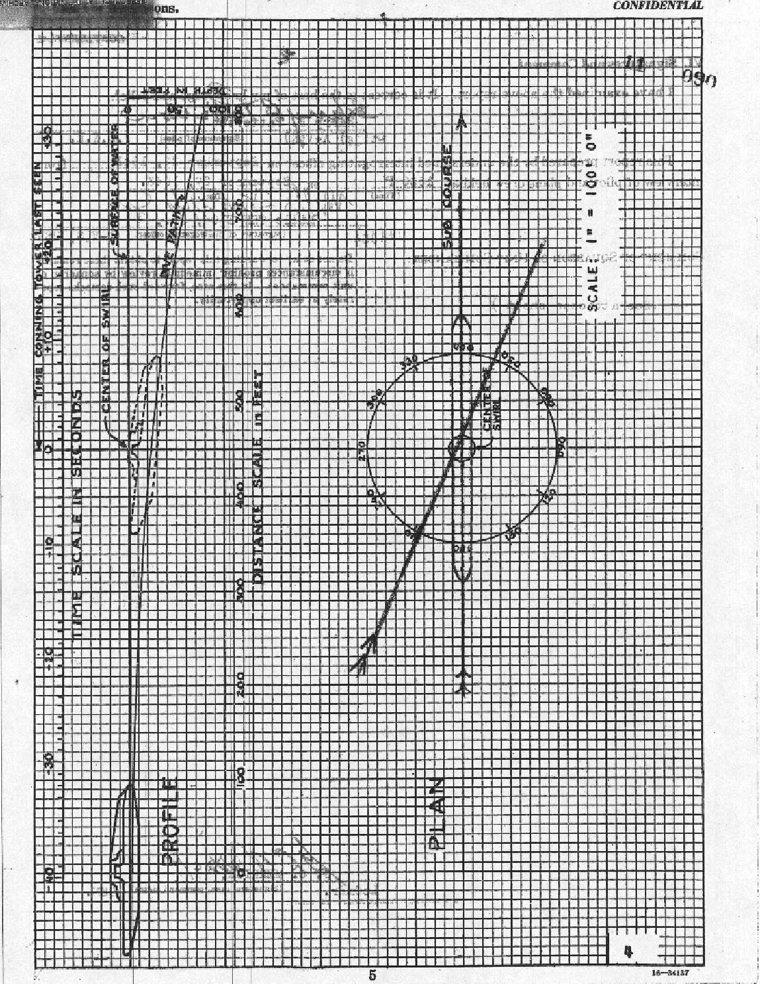
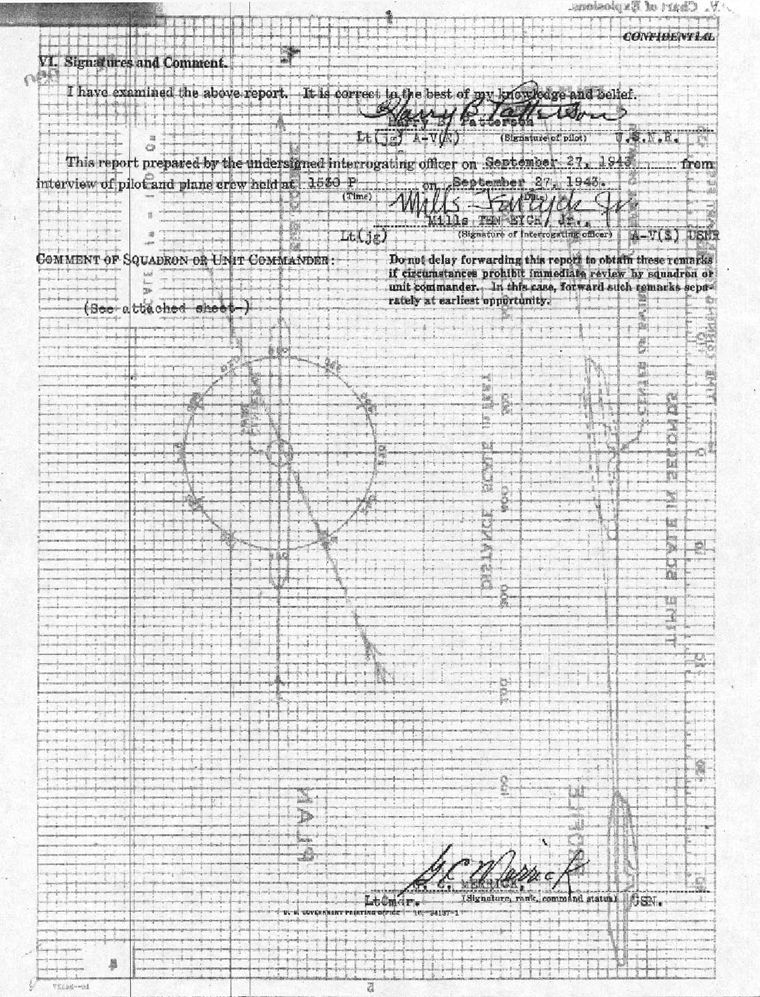
| COMMENT OF SQUADRON OR UNIT COMMANDER: | |||
| Two attacks were made in the face of the heaviest A.A. fire yet encountered. Though they did not result in a kill, valuable information was gained from photographs taken, from observation from the pilots and crew, also from survivors of the merchantmen, ST. USK, sunk by this or a similar submarine. Since this was the first submarine of this type, with the added mount aft, seen in this area, the following information is of interest: | |||
|
|||
| The submarine's best defense is to present its stern to the plane (which it did), and bring six guns to bear. Attacks would be made from forward aft if time permits. Second choice is a beam attack (especially if sea is rough). If two planes are present, plane astern strafe, engaging sub's fire, other plane make run from bow. | |||
| Two 37mm hits on the plane did more damage than many 20mm hits. The guns were manually controlled. The survivors stated the 20mm quadruple mount aft has two wing shields which open out when in use. These protect the pointer and trainer. They are folded back and the ammunition cans are sent below prior to submergence. They also stated whereas the 4.1 gun was rusty, the quadruple mount was shiny and showed perfect care. | |||
| The submarine maintained an efficient lookout watch of 4-6 men on C/T watching for aircraft. There was no evidence of radar | |||
| On two successive days the submarine was sighted on the surface in an area where there were no clouds for at least 12 miles in any direction. The submarine was sighted to eastward the following day by another Mariner of this squadron, who immediately commenced a run at 210 knots. | |||
| As there was no cloud cover, he was sighted 12 miles distant; the submarine crash dived immediately, and was down 80 seconds prior to the plane's arrival at the swirl. | ||
| On September 27th, the bow gunner believed he wounded or killed the 36mm gunners on the C/T, and possibly wounded others aft, so this particular submarine may be short of gunners, which may have accounted for his change of tactics. Also, he was probably damaged aft as he maneuvered erratically prior to submergence. | ||
| The psychological advantage gained through his failure to shoot down the plane, or prevent two attacks, may have left him in doubt as to the effectiveness of his A.A. fire. | ||
| It is agreed by those who saw the explosions, that the first six DC's were slightly over to starboard from C/T to stern. The next two were on starboard quarter, believed within damage range of submarine's stern. | ||
| 100' of 16mm film is enclosed for study of drops. No viewer has been available here. | ||
| As previously stated, the attacks were delivered in face of the heaviest A.A. fire yet encountered. They were courageously made. Especially to be commended are the pilot and radioman; the latter, though wounded, continued to send messages and M.O.'s until relieved. | ||
| G. C. MERRICK | ||
| FILE: FAW16/P16-3 UNITED STATES ATLANTIC FLEET | ||||||||||||||||
| SERIAL: 0170 AIR FORCE | ||||||||||||||||
| FLEET AIR WING SIXTEEN | ||||||||||||||||
| CONFIDENTIAL | ||||||||||||||||
| C/o FLEET POST OFFICE | ||||||||||||||||
| NEW YORK, N.Y. | ||||||||||||||||
| 20 October 1943 | ||||||||||||||||
| FIRST ENDORSEMENT to | ||||||||||||||||
| VP74/A16 ser. (073-A) | ||||||||||||||||
| o 10 October 1943. | ||||||||||||||||
|
||||||||||||||||
| 1. Forwarded. | ||||||||||||||||
| 2. The Commander, Fleet Air Wing SIXTEEN, concurs with the remarks of the Squadron Commander. It is the doctrine of Fleet Air Wing SIXTEEN to deliver a decisive and immediate attack. When the element of surprise has been eliminated, the doctrine stresses an attack from forward of the beam of the submarine, with an attempt to maneuver the submarine in such a direction as to place the enemy's longitudinal axis in the trough of the sea and thus impair the accuracy of his fire. | ||||||||||||||||
| 3. Unfortunately the continuous gambit hold down tactics were interrupted, due to weather, during the third night. | ||||||||||||||||
| 4. It is assumed that the submarine departed this area immediately as no further attacks or sinkings have occurred in this area. | ||||||||||||||||
| 5. The pilot and his crew are to be commended for their vigorous attack. | ||||||||||||||||
| 6. By copy of this endorsement, negatives of the action, with some 16MM film, are herewith forwarded direct to Commander-in-Chief, United States Fleet. | ||||||||||||||||
 |
||||||||||||||||
| R. D. LYON | ||||||||||||||||
| Copy to: | ||||||||||||||||
| CVP-74 | ||||||||||||||||
|
||||||||||||||
| C-O-N-F-I-D-E-N-T-I-A-L | ||||||||||||||
| 27 OCT 1943 | ||||||||||||||
| SECOND ENDORSEMENT to | ||||||||||||||
| VP74/A16 ser. (073-A) | ||||||||||||||
| of 10 October 1943. | ||||||||||||||
|
||||||||||||||
| 1. Forwarded. | ||||||||||||||
 |
||||||||||||||
| C. R. WILL | ||||||||||||||
| Assistant Chief of Staff. | ||||||||||||||
| Copy to: | ||||||||||||||
| CinClant. | ||||||||||||||
| Comairlant | ||||||||||||||
| Asdevlant. | ||||||||||||||
| FAW-16. | ||||||||||||||
| VP-74. | ||||||||||||||
UNITED STATES ATLANTIC FLEET |
||
PATROL SQUADRON SEVENTY-FOUR |
||
| CONFIDENTIAL | ||
| Photographs of U/B taken by Mariner 2 following second attack. | ||
| (1) and (2), Taken from tunnel hatch. | ||
| From rough measurements size is estimated to be 1200 tons. Note elongated C/T structure and evident high speed. Visible armament consists of foredeck (4 in.) gun; 2 37mm in first bandstand of C/T; 4 20mm in a quadruple mount on after bandstand.* White raised surface on C/T is cover for light. Small fire can be seen on aft deck near C/T base. | ||
| (3), (4), and (5), Taken from waist hatch. | ||
| U/B shortly before submergence. Note erratic track taken. | ||
| * Interrogation of survivors of S. S. ST. USK, British merchantman, who identify U/B as their attacker, revealed following information re armament. | ||
| (1) Men were taken aboard and questioned on C/T deck beneath guns on forward bandstand, Quadruple 20mm mount was trained on them during entire period on board. C/T guns were beautifully clean. (Foredeck gun was rusty) Had side feed magazines stacked behind shields, which folded inboard around mount when gun was not manned. Magazines stowed in about 6 scrap basket-sized containers on deck forward on rotating platform. These had spherical caps with clamps. As ST. USK men left submarine, guns were unloaded and magazines stowed in these containers. Mount was manned by two men. Guns were arranged in vertical pairs with sighting space between them. | ||
| Survivors also reported constant alert lookout of 4-6 men with large binoculars, scanning sky, (more often than horizon), though U/B position at that time was over 500 miles from land. | ||